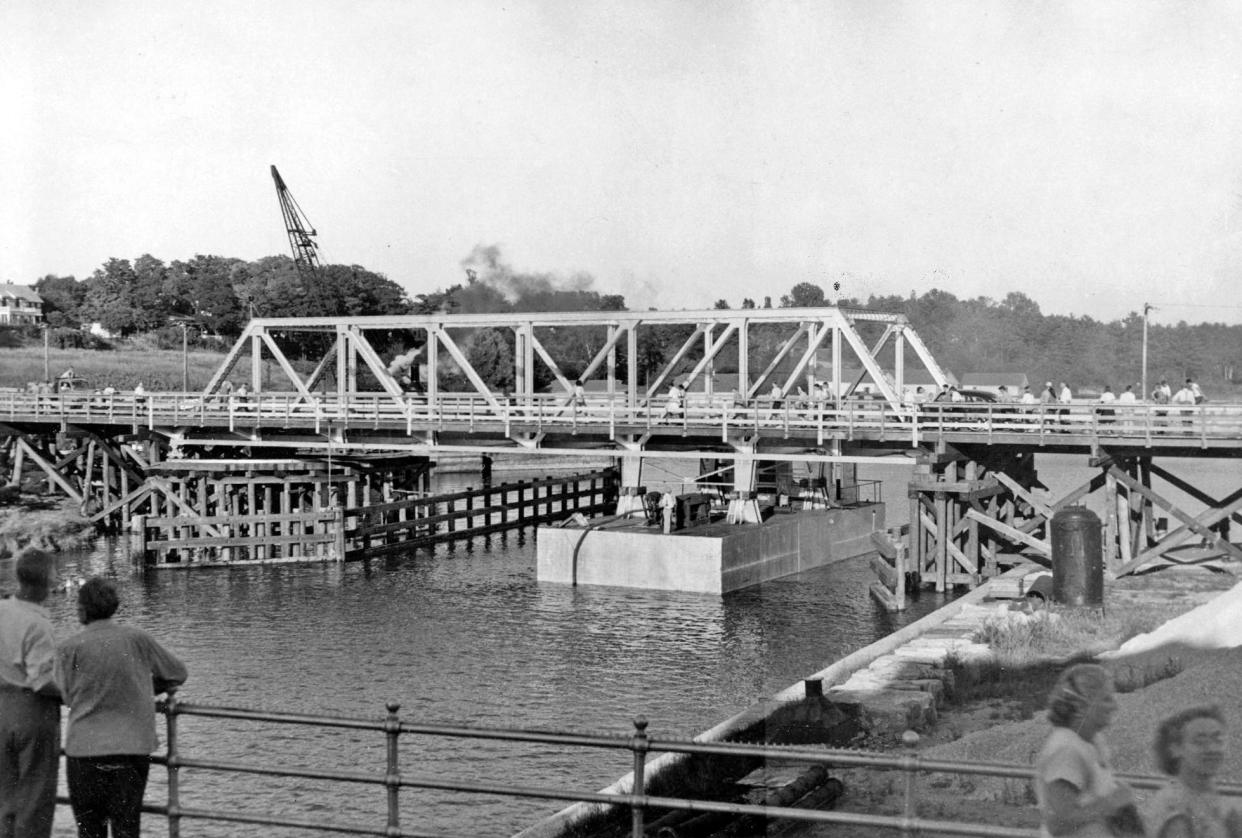Looking Back: Charlevoix's iconic bridge turns 75

CHARLEVOIX — The year 2024 marks the 75th anniversary of the opening of Charlevoix’s sixth lower channel bridge.
This Looking Back is the first of four that will trace how it came to be, its construction start and interruption by a world war, and eventual finish six years later than planned and hoped for. The result was an iconic Charlevoix landmark that has come to be known all over the world.
The town’s fourth bridge, a powerfully designed, dynamic openwork girder structure installed in 1901, was beginning to show its age in the 1930s after untold thousands of openings. It still had a wood plank roadbed that needed constant replacement. Even during the Great Depression, when the country was at a low economic point, the necessity of change became so apparent that by late in the decade plans were formulated and drawn up, and almost reached fruition. Bond issues were planned, steel was ordered but couldn’t yet be delivered due to scarcity, and after the summer of 1941 five pioneer commercial buildings on the northeast end of Bridge Street were purchased and removed to make way for construction. That is the stretch of land now known as Bridge Park next to the Paddleworks/Bridge Street Tap Room building.
But then came Pearl Harbor. No critical resources could be spared now that the country was at war. The drawings and plans were rolled up and shelved in the basement of City Hall. So the much loved old bridge had to suffice beyond its intended life span for a total of 46 years, antiquated but serviceable, if a little creaky, and still part of the memories of many residents.
Subscribe: Check out our offers and read the local news that matters to you
Once the war ended in 1945, critical materials came back on the market for civilian use. Vehicular traffic began to increase enormously and was not about to subside. A new bridge would be a local symbol of the self-confidence and faith in the future that were sweeping the country. So the plans and drawings were retrieved from City Hall, dusted off and sent downstate to an agreeable welcome. The Michigan State Highway Commission decreed a stately new span. An initial bond issue of $349,000 got the project off the ground.
In May of 1947, and for the next three months, a “temporary float” swing bridge began to take shape across the neck of the channel 200 feet east of the highway crossing. It opened on Aug. 26, and from then until June 27, 1949, Charlevoix had to endure this intriguing but irksome slowpoke as it witnessed the greatest construction project in its history, the million-dollar Memorial Bridge.
The streetside gap where the old buildings had stood was filled with tall gravel piles and the access road to the temporary bridge. This detour angled in from Bridge Street, curved left and continued along an elevated roadway, crossed the temporary onto another roadway raised through what is now the Edgewater Inn, then snaked up the hill and exited into little two-block Nicholls Street which for 22 months became temporary U.S. 31 leading to the main highway, Petoskey Avenue.
The worst inconvenience of the temporary bridge was the amount of time needed to open and close it. In terms of speed, this was a retrogression to the age of the dinosaurs. The temporary sat on a huge, ugly rectangular pontoon connected by way of cables to anchored winches that would turn it into Round Lake. Bridges #3 and #4, both also swinging spans, were few-minute jackrabbits compared to the lumbering snailspeed sloth of #5. Kids walking to and from school had an easy excuse for tardiness. The joke of drivers at the time was, if caught by the opened bridge, just turn off the ignition, lie down on the seat, and have yourself a good snooze. Some openings could take half an hour. To think of today’s road and water traffic is to think in terms of one’s worst nightmare.
Once #5 was in place, $30,000 was expended to take out #4. For many in Charlevoix, the girder-torching sight was a tremendously emotional, wrenching experience because this bridge had been the only one they’d ever known. As the old girders came down one by one, it was not unusual for clusters of spectators to gather on the closed-off Bridge Street section south of the crossing and have themselves a good cry.
Next week: How to build a bridge.
To honor this important anniversary year, on Tuesday, July 16 this writer and the Charlevoix Historical Society will be presenting a completely illustrated program on the eventful history of all six of Charlevoix’s lower channel bridges at the Charlevoix Public Library Community Room, 6 p.m., admission free. Call (231) 547-0373 for more information.
This article originally appeared on The Petoskey News-Review: Looking Back: Charlevoix's iconic bridge turns 75
